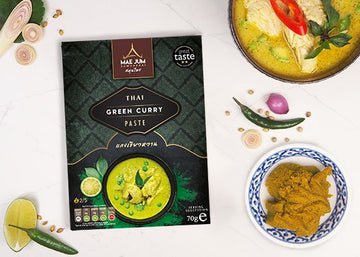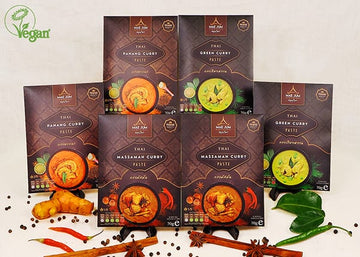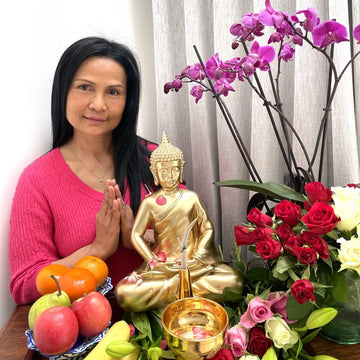Thailand is a land where spirituality weaves into daily life like threads in a silk scarf. Few days showcase this better than Asalha Puja and Khao Phansa, one of the most important and serene Buddhist festivals in the Thai calendar. Held on the full moon of the eighth lunar month—this year falling on Thursday, 10 July 2025—Asalha Puja is a day to honour the Buddha’s first sermon and the birth of the Sangha, or monastic community.
Whether you’ve witnessed it in person or are dreaming of your next cultural adventure, join me as we explore the traditions, meanings, and beautiful rituals of Asalha Puja in Thailand.
Contents
 The History and Teachings of Asalha Puja
The History and Teachings of Asalha Puja
Asalha Puja commemorates the day over 2,500 years ago when the Buddha gave his very first sermon after attaining enlightenment under the Bodhi tree. This discourse, delivered in the Deer Park of Sarnath to five ascetics, is known as the Dhammacakkappavattana Sutta, or Setting the Wheel of Dhamma in Motion.
In this profound teaching, the Buddha introduced the Four Noble Truths, which form the foundation of Buddhist philosophy:
-
Dukkha – The truth of suffering: life inevitably involves suffering, dissatisfaction, and impermanence. But this is not a pessimistic view—instead, it's a clear-eyed acknowledgment of the human condition. By recognising that life includes illness, aging, loss, and emotional discomfort, we begin to understand that these challenges are universal and natural.
In Buddhism, understanding suffering is the first step toward liberation. Rather than dwelling in negativity, the teaching of Dukkha invites its followers to develop wisdom and compassion through mindful awareness of life's changing nature.
-
Samudaya – The origin of suffering: craving and attachment are the root causes. This teaching encourages us to look closely at our own desires—our longing for pleasure, possessions, approval, and permanence.
It's not that desire is inherently evil, but rather that our attachment to these impermanent things creates emotional turmoil. By understanding this cause, we can begin to loosen our grip and create space for peace and acceptance.
-
Nirodha – The cessation of suffering: by letting go of craving, suffering can end. This truth offers profound hope.
It tells us that freedom from suffering is not only possible, but achievable through inner transformation. Letting go does not mean withdrawal or indifference—it means releasing the tight hold of expectations and embracing a state of equanimity, clarity, and joy.
-
Magga – The path to the end of suffering: the Eightfold Path offers a practical guide to liberation. This path is not a rigid set of rules but a balanced and holistic framework for living.
The 8 steps include right understanding, right intention, right speech, right action, right livelihood, right effort, right mindfulness, and right concentration. Each step is meant to be practised with sincerity and patience, leading to insight, compassion, and lasting freedom.
This sermon not only marked the beginning of the Buddha's teaching mission, but it also led to the enlightenment of his first disciple, Kondanna. With this, the Sangha (community of ordained monks) was born, forming the third pillar of the Triple Gem: the Buddha, the Dhamma (his teachings), and the Sangha (his disciples).

Asalha Puja 2025: Dates and Timing
In 2025, Asalha Puja falls on Thursday, 10 July, followed by Khao Phansa (Buddhist Lent) on Friday, 11 July. These two days are often observed together, with many Thais making merit, attending temple services, and preparing for the Lent retreat period when monks stay in their monasteries for three months of study and meditation.
Both days are public holidays in Thailand, with government offices and most businesses closed. Thailand generally bans the selling of alcohol of Buddhist holidays such as this.
How Thais Celebrate Asalha Puja
A Day of Merit-Making
In the early morning, families visit their local temples (wats) to make merit—offering food, robes, and essentials to the monks. It’s a time for reflection, generosity, and community spirit. Many also donate candles, symbolic of light and wisdom, as monks prepare for their rainy season retreat.
Listening to Sermons
Monks deliver sermons, known in Thai as Thamma desana, that recount the Buddha’s first discourse and explore key teachings such as the Four Noble Truths and the Noble Eightfold Path. A sermon is essentially a Dhamma talk: part spiritual lesson, part reflection, and often rich with parables or metaphors to help listeners apply Buddhist wisdom in everyday life.
These are often accompanied by chanting and guided meditation sessions. The atmosphere is respectful and serene, a moment of pause in the rhythm of life.
The Candlelight Procession (Wian Tian)
As dusk falls, the atmosphere transforms. One of the most memorable parts of Asalha Puja is the Wian Tian candlelight procession. Wian Tian is a truly enchanting ritual that takes place after sunset on Asalha Puja. It involves walking three times around the temple's ordination hall (ubosot), holding a trio of symbolic items: a candle (light and wisdom), incense sticks (purity), and a lotus flower (spiritual awakening). Each circuit represents one of the Three Jewels: the Buddha, the Dhamma (his teachings), and the Sangha (his disciples).
Insert image: Wian Tian candlelight procession at a temple
For visitors and tourists, joining a Wian Tian is not only possible, it's deeply welcomed—so long as it’s done with respect.
How to Join as a Tourist:
- Dress Modestly: Wear clothing that covers your shoulders and knees. Light, breathable fabrics are best.
- Arrive Before Sunset: Most Wian Tian processions begin just after dusk. Arriving early gives you time to observe the temple grounds and take in the serene atmosphere.
- Collect Your Offerings: You can often buy a small set (candle, incense, lotus) at a modest cost from vendors near the temple entrance. Prices are usually 20–50 baht.
- Follow the Locals: Join the procession, walking clockwise around the ubosot three times. Silence or soft chanting is encouraged. If you're unsure, simply observe and follow others’ lead.
- Respect the Sacred Space: Refrain from taking flash photography or using your phone during the ritual. It's a time for inner stillness and reverence.
The experience is moving, even for those unfamiliar with Buddhism. As the candle flames flicker and feet gently tread the temple grounds, there’s a palpable sense of unity and spiritual calm.

After completing the three rounds, it's customary to place your offerings—candle, incense sticks, and lotus flower—at designated spots in front of the ubosot or within the temple's main altar area. This final act is symbolic: letting go of one's desires and offering merit to the Buddha and the spiritual community. Temple staff or local devotees often guide where to place them, and you may see a beautiful array of glowing candles and fragrant blooms left behind in quiet devotion.
Travel Tip: If you're in Chiang Mai, try visiting Wat Phra Singh or Wat Suan Dok. In Bangkok, Wat Saket and Wat Benchamabophit often host well-attended and visually stunning processions.
Khao Phansa and the Start of Buddhist Lent
The day after Asalha Puja is Khao Phansa, marking the beginning of Buddhist Lent. For the next three months, monks traditionally stay within their temples to meditate, study, and refrain from travel. This period coincides with the rainy season, and historically it was both a spiritual retreat and a practical measure to avoid damaging rice fields under cultivation.
But Khao Phansa doesn't just affect the monks—its influence ripples through Thai society in visible and subtle ways.
Everyday Life During Buddhist Lent
-
Monastic Presence: With monks remaining in one place, temples become more active hubs for local communities. Villagers often gather more frequently for evening chanting, Dhamma talks, and communal merit-making.
-
Personal Resolutions: Many Thai Buddhists take this time to set personal spiritual goals—such as giving up alcohol, smoking, or meat, or committing to daily meditation and increased acts of generosity.
-
More Ordinations: It’s a common time for men to enter monkhood, even temporarily. Families proudly celebrate their sons' ordinations, often hosting vibrant processions and ceremonies.
-
Cultural and School Activities: Schools may organise field trips to temples, and many communities hold candle festivals or educational events around Buddhist ethics and mindfulness.
- Retail and Social Spaces: In rural areas especially, bars may close early or see less traffic, and restaurants often promote vegetarian dishes or Lent-friendly meals.
In essence, Khao Phansa represents a national moment of inward turning. While life doesn’t stop, many people consciously slow down, reflect, and realign with values of compassion, moderation, and self-awareness.
Did You Know?
During Lent, many Thai men temporarily ordain as monks, even for just a few weeks as a rite of passage and to earn merit for their families. It’s not uncommon to see ordination ceremonies take place right before Khao Phansa.
Asalha Puja and Thai Cuisine
While Asalha Puja is primarily spiritual, food remains a big part of the day, especially in merit-making rituals. Families prepare dishes to offer monks, and traditional Thai curries are often included. The last time I was in Thailand for this festive holiday, I helped prepare an array of dishes to take to the temples. I prepared Gaeng Som, a southern sour curry with tamarind and turmeric. I also made stir-fry vegetables, hor mok and a Thai dessert.
Vegetarian food also plays a significant role, particularly during Khao Phansa when many people choose to abstain from meat as an act of purification and compassion. Simple yet delicious dishes like Pad Thai with tofu, stir-fried mixed vegetables, and green curry with aubergine are commonly served. These meals are not only respectful offerings for monks, who can only eat if food is donated to them, but also represent mindful choices in everyday Thai homes.
Recipe Corner: Want to try a vegetarian Thai dish at home?
Explore a range of plant-based recipes in the Mae Jum Vegan Recipe Collection and experience the depth of flavour that traditional Thai herbs and spices can bring—no meat required! Check out the recipes here.
A Time for Reflection
More than a celebration, Asalha Puja invites us to reflect on life’s deeper meaning. Whether you're standing barefoot in a candlelit temple courtyard or quietly lighting incense at home, this day offers a moment of stillness—a chance to reconnect with values of mindfulness, compassion, and clarity.
Asalha Puja is a sacred and soul-stirring celebration. It's a day when Thailand slows down, when hearts open, and when ancient teachings shine ever brightly. Whether you're Buddhist or simply a respectful observer, this is one of those cultural experiences that stays with you long after the candles are extinguished.
If you’ve experienced Asalha Puja in Thailand, I’d love to hear your stories—drop a comment or share a photo of your favourite temple moment.







